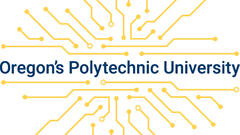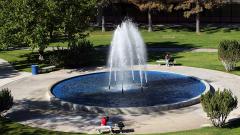It wasn't hard to find inventions that could heavily impact society at Oregon Institute of Technology's project symposium on the Wilsonville campus. From stair-climbing robots to a virtual reality experience that could easily be implemented in the classroom, to a rover designed to detect harmful toxins with the ability to scope out the safety of an enclosed area like a cave, the science symposium boasted 81 senior projects — with some junior projects — from undergrad and graduate students.
The annual project symposium is a culmination event where students present their projects that they have spent the last year creating. Projects in renewable energy, healthcare and engineering, to name a few, were all on display for the public June 5, 2019. "These projects are physical inventions like a robot for example, or an e-invention like a new piece of software or an application that improves the industry that they are going into," said Di Saunders, associate/vice president of communications and public affairs at Oregon Tech. The average age of students at Oregon Tech are about 30 years old, "many of whom are working now, or returning to school after hitting a wall where they see they need a degree to advance," Saunders added.
Students had the ability to talk about their projects with industry professionals who are looking to recruit student talent and future employees. "My favorite part was seeing how proud the students (and their families) were of their projects after a year of hard work and dedication. A student told me he was surprised by the high interest in his work from industry," said Oregon Tech Professor and Project Adviser Aaron Scher. "The symposium gives students an opportunity to get feedback from people with diverse backgrounds and experiences. Sometimes the right question or recommendation from an attendee can spark an 'aha moment' for students that leads to new ideas and opportunities. It can be thrilling and scary for students to unveil their capstone project for the first time for all the world to see. It is akin to an artist unveiling their art at their first show at an art gallery."
About nine months ago Brian Locke, Riggs Burnham, Cobe Greene and Yang Wang decided to create a virtual reality experience designed to be used in the classroom. The students created a website that allows people to quickly lay out content like pictures and 3D models, and organize it into an "exhibit" for people to explore when they put on the virtual reality headset. People then use a QR code to connect to the website from their phone or tablet.
"It's as easy as making a PowerPoint," Locke said. "We thought it would be helpful in trying to help students or engineering students really be able to experience a concept more than just be able to see it on a 2D piece of paper." The project is also cost effective. Instead of spending hundreds of dollars on an industry standard virtual reality headset, their project uses Google Cardboard glasses that allow people to slip their phone inside the cardboard holder to have a virtual reality experience." You can actually see all around the object," Burnham said.
Francis Bartholomew, who's receiving both his undergrad and graduate degree simultaneously in embedded systems this month, created a rover with his partners Zachary Hofmann, Peter Tucker, Krystal Cruz, Danyle Miles, Vicki Depew and Josh Hofmann. Each engineering student was responsible for creating a particular portion of this collaborative project. "We all brought a lot to the table and a project like this really leverages everything we've got to build a system that can be used to remotely explore potentially harsh and dangerous environments," Bartholomew said.
The device — which is currently on wheels, but can be altered to fit on a drone, on treads and for use underwater — can move as directed from the remote hand controller. The rover contains a stereoscopic camera, 2D and 3D LiDAR sensors — laser scanners — and more. "So when you get deployed into a cave, for example, we can enable the 2D LiDAR. It will take a moment and suddenly swing the lasers around to establish a map of where the device currently is. Then we can proceed forward and do it again, generating an ever-more accurate and complete map of that space," Bartholomew said, adding that the 3D LiDAR would be used to collect data about the ceiling, the floor and potential obstacles, whereas the 2D works at the level it is at. If people wanted to know the composition of the atmosphere in the cave, the 2D LiDAR could be removed and replaced with a gas spectrometer or even a high definition camera if people wanted to take photos of certain cave formations.
"It could be full of methane. For all we know something terribly toxic. You wouldn't want to send a person down in there and you'd have to carefully navigate that environment," Bartholomew said. The rover could be useful for search and rescue in areas humans can't yet navigate themselves. "All through my time here at Oregon Tech, I've been involved in various space or space applicable related projects," Bartholomew said. "My goal is to work for one of the space agencies or one of the major contractors involved in space-related science." Bartholomew added that he wants to eventually help humans survive in the future when they can no longer live on Earth.











